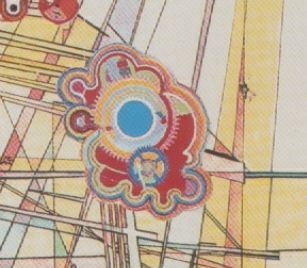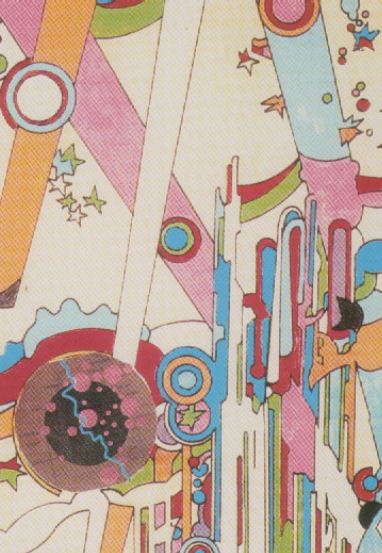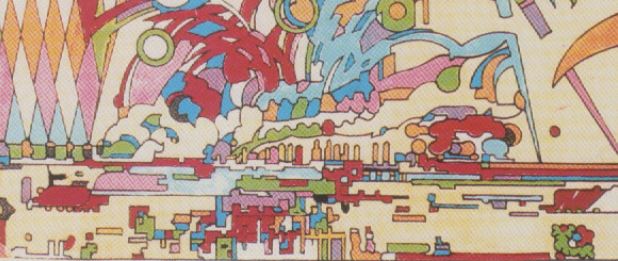T H E T U R I N G
C O L L E C T I O N
a look at Paolozzi's images
for an introduction to the Turing Collection.
|
You should also refer to the complete web-display of the prints on PrintEditions. The images on this page are presented only to illustrate certain iconographic details and do not give a correct impression of the colours, printed texture, or scope of the complete art-works.
The prints are not numbered on the PrintEditions page. They are actually in the order: 4, 3, 5, 7 (top row) and then 3, 8, 9, 1/2 (bottom row). |
These comments are based on the talk that I gave at Oxford on September 24 2000, as part of a public event on the theme of Mathematics and Art.
IMAGE 1/2:This image is twice the size of the others, being in 'landscape' rather 'portrait' form.
In the rays we see germs of thoughts, perhaps DNA machines in cells, but this print also recalled to me an image from my own childhood: the fascination of 'seeing' surreal shapes when in complete darkness. IMAGE 3Paolozzi's text for this print is drawn from my discussion of Turing's 1948 paper on the beginnings of Artificial Intelligence theory, showing how his discussion learning and discovery was related to his own childhood experience and social training.This is the one image where there is a reference to the human body, but perhaps it is more the body politic, the system, in which an individual is only a pawn in the game, a cog in the machine. One of Turing's major concerns was with the problem of explaining his own originality as something that an intelligent machine could do. This was remarkable as he of all people, after his code-breaking efforts, could have exalted the role of individual in history — but he didn't. Instead, he said how little a man can do, and discussed 'cultural search.' IMAGE 4The fourth print refers clearly to chapter 4 of my book, which is about Turing's successful work on the Enigma problem after 1939. It quotes 'THE RELAY RACE', my chapter title, and the vigour and colour of the 'machinery' suggests the way that the concept of 'the mechanical' completely changed its meaning during the Second World War, propelling Turing towards the conviction that machines could do anything the human mind could do.At this point I would however criticise Paolozzi's use of bits of equations and formulae from maths-books, in this and in the later prints in the series. Logarithm tables and scraps of elementary geometry have virtually no connection with the Turing material. This kind of collage is too close to the spirit of cartoonists (and book-jacket designers) who unthinkingly juxtapose Weird Science Things to make a meaningless image conveying 'incomprehension'. In fact, mathematical expressions are not there to create mysteries, but to give crystal clarity. Pictures will not explain the all-important concepts embodied in the Universal Turing Machine. Pictures will not say why Turing's ideas were powerful enough to anticipate everything that computers do now. IMAGES 5-8I can say little about these. The texts of image 7 are more concerned with the interface of this work with art history and architecture. I think that Sir Eduardo told me that one of them was 'the German war machine,' but I cannot tell which it was!I would actually think of them as something much more abstract: namely images of intense mental concentration, something common to work at the highest level in both science and art, but almost impossible to convey in words. I think of music as the medium that is closest to communicating that abstract concentration, especially in intricate counterpoint, but in these works Paolozzi comes to do something similar without the connotations of social class and religion that bedevil classical musical performance. IMAGE 9
The 1939 World Fair was the last great civilian event of the world before war: it was also the American world of colour film and Superman, the rich civilian world that in the end triumphed and eclipsed all the old British social machine that Turing grew up in. After my talk in Oxford, Kip Gresham the print-maker pointed out the stream train puffing into the future, the train of thought, the grotty old British imperial world that had triumphed but now was finished. Paolozzi has avoided telling the story of what happened after 1945 but Alan Turing's downfall is all foretold in this last print. |
|
Alan Turing: the enigma |
Alan Turing Home Page |


